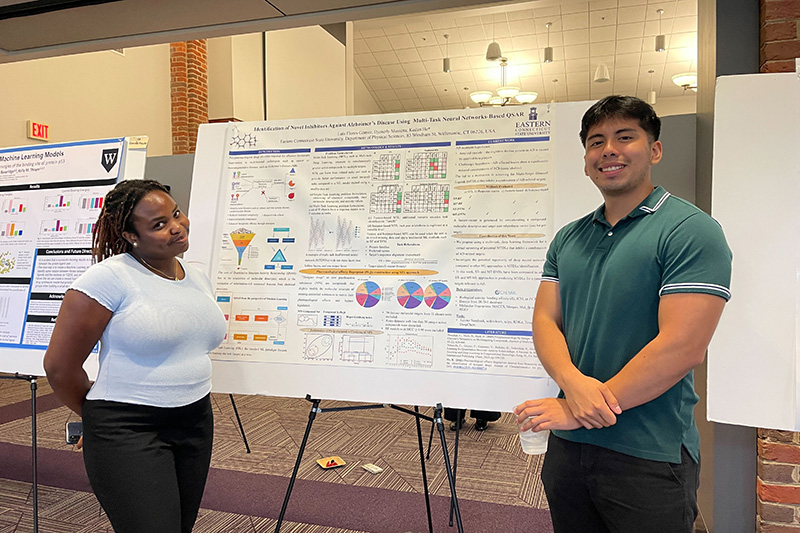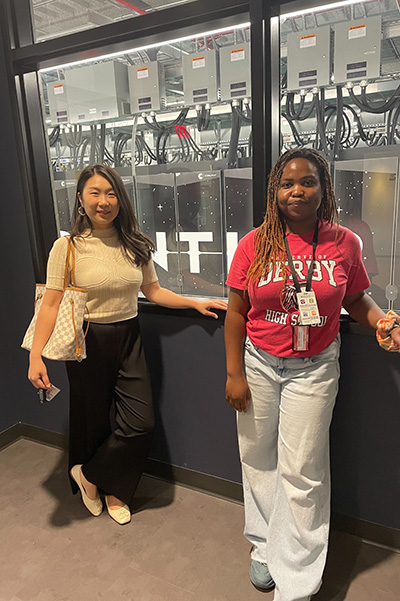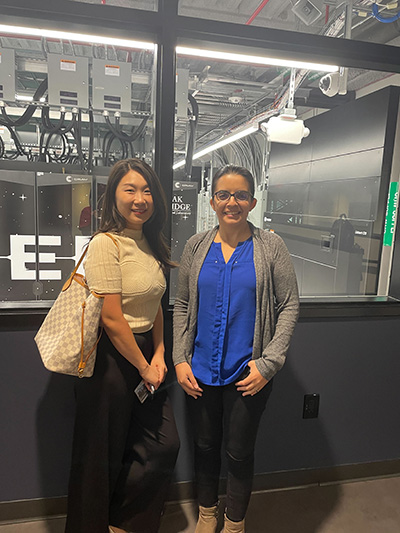- Apply
- Visit
- Request Info
- Give
Biochem students use supercomputers to study complex disease treatments
Written by Lucinda Weiss
Published on September 18, 2023

Three biochemistry students at Eastern Connecticut State University are expanding their understanding of how supercomputers can be used to solve complicated health issues, under the guidance of Kedan He, assistant professor of chemistry and the only computational chemist at Eastern.
Two of the students, seniors Djenerly Massena and Luis Flores-Gomez, presented a research poster at a conference where He taught a workshop this past summer at Furman University. Massena also partnered with He in a program at Oak Ridge National Laboratory, where they used the lab’s supercomputers to run simulations with a large-scale data set. A third student, junior Paula Yanez, is working on computational research with He, who is applying to partner with her on research at a national laboratory next summer.
The students are learning complex computational methods to solve challenging problems in treating diseases. At Oak Ridge, He and Massena worked on advanced machine learning models that could help identify small molecules that could be turned on in new drugs to treat cancer or Alzheimer’s disease.
“Imagine if we could find a single ‘magic pill’ that could treat a complicated health issue,” He said. For a disease like Alzheimer’s, such special pills could target different parts of the disease mechanism at once.
“Instead of asking the computer to learn one thing at a time, we are giving it data to allow it to learn many things all at once. This is called ‘multi-task learning,’” she said. The computer can then draw on what it found to help it solve another problem.
The “deep learning” models they use mimic how the human brain works. “The resulting model can potentially make the progress of finding new treatments faster and more effective,” she said.
Flores-Gomez and Massena presented the researchers’ poster on “Identification of Novel Inhibitors Against Alzheimer’s Disease Using Multi-Task Neural Networks-Based QSAR” at a MERCURY conference at Furman University in July. Professor He joined MERCURY (the Molecular Education and Research Consortium in Undergraduate Computational Chemistry) in 2018. It provides faculty and students from 47 primarily undergraduate institutions around the country with networking opportunities and summer conferences and a resource their home institutions lack — high-performance computing.
Massena also partnered with He as a faculty-student team on research for 10 weeks from June to August at Oak Ridge as part of a selective Sustainable Research Pathways (SRP) program that connects underrepresented groups and students from small colleges and universities with U.S. Department of Energy national laboratory scientists.
He is applying to work with Yanez next summer at a similar national laboratory SRP program. In that research project, they will look at new ways to treat prion diseases. These are rare diseases that affect the brain when normal proteins fold in abnormal ways, leading to a chain reaction that causes the brain disease to progress.
Among the types of prion diseases are “mad cow” disease in cattle and Creutzfeldt-Jakob disease in humans.
“Finding a treatment is hard because we don’t have a lot of details about these harmful misfolded proteins and how this chain reaction is triggered,” He said. They will use computer simulations to learn how proteins interact with each other.
“It’s like finding the best way for two puzzle pieces to fit together,” He said. If they can find certain spots on proteins that are important for this fit, they could insert small molecules into the interface to prevent protein interactions. It is challenging because the puzzle pieces (proteins) keep changing shape, she said.
Professor He’s latest publications examine the use of machine-learning techniques combined with bioactivity data to predict and analyze the effects of small molecules within biological systems.




